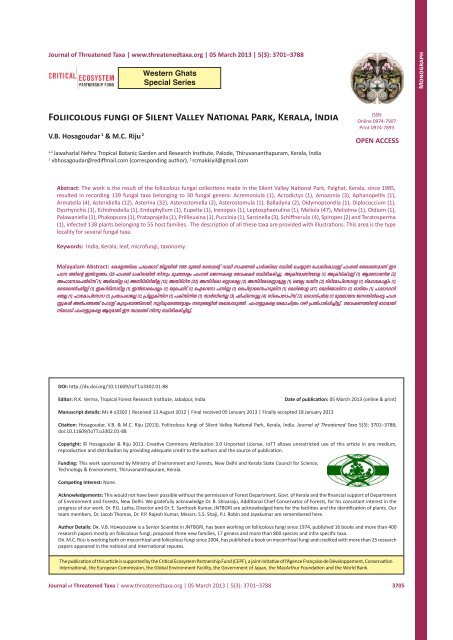PDF - Journal of Threatened Taxa
PDF - Journal of Threatened Taxa
PDF - Journal of Threatened Taxa
Create successful ePaper yourself
Turn your PDF publications into a flip-book with our unique Google optimized e-Paper software.
<strong>Journal</strong> <strong>of</strong> <strong>Threatened</strong> <strong>Taxa</strong> | www.threatenedtaxa.org | 05 March 2013 | 5(3): 3701–3788Western GhatsSpecial SeriesMonographFoliicolous fungi <strong>of</strong> Silent Valley National Park, Kerala, IndiaV.B. Hosagoudar 1 & M.C. Riju 21,2Jawaharlal Nehru Tropical Botanic Garden and Research Institute, Palode, Thiruvananthapuram, Kerala, India1vbhosagoudar@rediffmail.com (corresponding author), 2 rcmakkiyil@gmail.comISSNOnline 0974-7907Print 0974-7893OPEN ACCESSAbstract: The work is the result <strong>of</strong> the foliicolous fungal collections made in the Silent Valley National Park, Palghat, Kerala, since 1985,resulted in recording 139 fungal taxa belonging to 30 fungal genera: Acremoniula (1), Acrodictys (1), Amazonia (3), Aphanopeltis (1),Armatella (4), Asteridiella (12), Asterina (32), Asterostomella (2), Asterostomula (1), Balladyna (2), Didymopsorella (1), Diplococcium (1),Dysrhynchis (1), Echidnodella (1), Endophyllum (1), Eupelte (1), Irenopsis (1), Leptosphaerulina (1), Meliola (47), Meliolina (1), Oidium (1),Palawaniella (1), Phakopsora (1), Prataprajella (1), Prillieuxina (1), Puccinia (1), Sarcinella (3), Schiffnerula (4), Spiropes (2) and Teratosperma(1), infected 138 plants belonging to 55 host families. The description <strong>of</strong> all these taxa are provided with illustrations. This area is the typelocality for several fungal taxa.Keywords: India, Kerala, leaf, micr<strong>of</strong>ungi, taxonomy.Malayalam Abstract: tIc-f-¯nse ]me-¡mSv PnÃ-bn 1985 apX sskeâ v hmen \mj-W ]mÀ¡nse ØnXn sN¿p t^men-tIm-eÊv ^wK tiJ-c-W-amWv Cu]T-\ ¯nsâ CXn-hr-¯w.139 ^wK SmIvkbn \npw ap¸-tXmfw ^wK sP\-d-Isf Kth-j-IÀ Ønco-I-cn-¨p. A{In-tam-Wn-tbmf (1), A{In-Sn-IvSÊv (1), Ba-tkm-Wnb (3),A^m-t\m-s]ÂSnkv (1), AÀam-Snà (4), AkvSn-cn-Sn-bnà (12), AkvSn-dn\ (32), AkvSnscm sÌmsaà (2), AkvSn-tcm-sÌm-ayqà (1), s_à Ubv\ (2), SnSn-tam-]vskm-dà (1), Snt¸m-tIm¢nw (1),ssSssd³OoÊv (1), CI-dn-Svt\m-Snà (1), C³tSm-ss^Ãw (1), bqs]evSv (1), sFsdt\m ]knÊ (1), se]vtämsskl-dp-en\ (1), saen-tbmf (47), saen-tbm-en\m (1), HmSnbw (1), ]mem-hm-\nsbÃ(1), ^mtIm-]vtkmdm (1), {]Xm-]cmPà (1), {]nÃp-Ivkn\ (1), ]Ivkn-\nb (1), kmÀkn-s\à (3), jn^vs\-dpà (4), kvss]tdm]vkv (2), sSdm-kv]À½ (1) apX-em-bh P\-d-bnÂs¸« ^wK-Êp-IÄ A³]-¯©v tlmÌv IpSpw-_-¯n-embn, \qän-ap-¸-s¯-t«mfw kky-§-fn tcJ-s¸-Sp-¯n. ^wK-Êp-Isf tcJm-Nn{Xw hgn {]Xn-]m-Zn-¸n-¨n-«p- v. Kth-j-W-¯nsâ `mK-ambn\nc-h[n ^wK-Êp-Isf BZy-ambn Cu Øe¯v \np Ønco-I-cn-¨n-«p- v.DOI: http://dx.doi.org/10.11609/JoTT.o3302.01-88Editor: R.K. Verma, Tropical Forest Research Institute, Jabalpur, IndiaDate <strong>of</strong> publication: 05 March 2013 (online & print)Manuscript details: Ms # o3302 | Received 13 August 2012 | Final received 05 January 2013 | Finally accepted 18 January 2013Citation: Hosagoudar, V.B. & M.C. Riju (2013). Foliicolous fungi <strong>of</strong> Silent Valley National Park, Kerala, India. <strong>Journal</strong> <strong>of</strong> <strong>Threatened</strong> <strong>Taxa</strong> 5(3): 3701–3788;doi:10.11609/JoTT.o3302.01-88Copyright: © Hosagoudar & Riju 2013. Creative Commons Attribution 3.0 Unported License. JoTT allows unrestricted use <strong>of</strong> this article in any medium,reproduction and distribution by providing adequate credit to the authors and the source <strong>of</strong> publication.Funding: This work sponsored by Ministry <strong>of</strong> Environment and Forests, New Delhi and Kerala State Council for Science,Technology & Environment, Thiruvananthapuram, Kerala.Competing Interest: None.Acknowledgements: This would not have been possible without the permission <strong>of</strong> Forest Department, Govt. <strong>of</strong> Kerala and the financial support <strong>of</strong> Department<strong>of</strong> Environment and Forests, New Delhi. We gratefully acknowledge Dr. B. Shivaraju, Additional Chief Conservator <strong>of</strong> Forests, for his consistant interest in theprogress <strong>of</strong> our work. Dr. P.G. Latha, Director and Dr. E. Santhosh Kumar, JNTBGRI are acknowledged here for the facilities and the identification <strong>of</strong> plants. Ourteam members, Dr. Jacob Thomas, Dr. P.P. Rajesh Kumar, Messrs. S.S. Shaji, P.J. Robin and Jayakumar are remembered here.Author Details: Dr. V.B. Hoagoudar is a Senior Scientist in JNTBGRI, has been working on foliicolous fungi since 1974, published 16 books and more than 400research papers mostly on foliicolous fungi; proposed three new families, 17 genera and more than 800 species and infra specific taxa.Dr. M.C. Riju is working both on mycorrhizal and foliicolous fungi since 2004, has published a book on mycorrhizal fungi and credited with more than 25 researchpapers appeared in the national and international reputes.The publication <strong>of</strong> this article is supported by the Critical Ecosystem Partnership Fund (CEPF), a joint initiative <strong>of</strong> l’Agence Française de Développement, ConservationInternational, the European Commission, the Global Environment Facility, the Government <strong>of</strong> Japan, the MacArthur Foundation and the World Bank.<strong>Journal</strong> <strong>of</strong> <strong>Threatened</strong> <strong>Taxa</strong> | www.threatenedtaxa.org | 05 March 2013 | 5(3): 3701–37883705

















